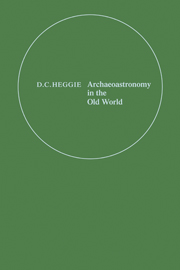Book contents
- Frontmatter
- Contents
- PREFACE
- LIST OF CONTRIBUTORS
- INVITED PAPERS
- CONTRIBUTED PAPERS
- A SURVEY OF THE BARBROOK STONE CIRCLES AND THEIR CLAIMED ASTRONOMICAL ALIGNMENTS
- OBSERVATIONS AT KINTRAW
- DECODING THE CALLANISH COMPLEX - A PROGRESS REPORT
- ASTRONOMY AND STONE ALIGNMENTS IN S.W. IRELAND
- STONE RINGS OF NORTHERN POLAND
- ASTRONOMICAL ORIENTATION OF NEOLITHIC SITES IN CENTRAL EUROPE
- STONE CIRCLE GEOMETRIES: AN INFORMATION THEORY APPROACH
- INVITED PAPER
- INDEX
A SURVEY OF THE BARBROOK STONE CIRCLES AND THEIR CLAIMED ASTRONOMICAL ALIGNMENTS
Published online by Cambridge University Press: 05 November 2011
- Frontmatter
- Contents
- PREFACE
- LIST OF CONTRIBUTORS
- INVITED PAPERS
- CONTRIBUTED PAPERS
- A SURVEY OF THE BARBROOK STONE CIRCLES AND THEIR CLAIMED ASTRONOMICAL ALIGNMENTS
- OBSERVATIONS AT KINTRAW
- DECODING THE CALLANISH COMPLEX - A PROGRESS REPORT
- ASTRONOMY AND STONE ALIGNMENTS IN S.W. IRELAND
- STONE RINGS OF NORTHERN POLAND
- ASTRONOMICAL ORIENTATION OF NEOLITHIC SITES IN CENTRAL EUROPE
- STONE CIRCLE GEOMETRIES: AN INFORMATION THEORY APPROACH
- INVITED PAPER
- INDEX
Summary
Abstract The Barbrook stone circles and their outliers have been the subject of a total of 16 claimed astronomical alignments (Thom 1967, Barnatt 1978). We have re-surveyed the sites in order to test these claims. In choosing alignments we have adhered to rigidly defined selection criteria, and we have applied the test of Freeman and Elmore, together with pseudo-random simulations, in order to test the significance of our results. We conclude that there is no evidence of any deliberate accurate astronomical alignments, although there is marginal evidence for rough astronomical alignments which may have been constructed for ritual purposes.
Introduction
The valley of Barbrook on Big Moor in Derbyshire was the site. of a major prehistoric settlement (Radley 1966, Burl 1976). The moor contains the remains of a number of stone circles, earthen enclosures, standing stones and cairns, some of which have been shown by Lewis (1966) to have existed in Neolithic and Early Bronze age times. One of the stone circles, Barbrook 1, has been claimed by Thom (1967) and by Barnatt (1978) to have been used by prehistoric man for astronomical purposes. In addition, Thom (1967) has suggested that Barbrook 1 and another nearby stone circle Barbrook 3 (also known as Owler Bar) were constructed according to an accurate geometrical method (Thom type B circles).
In order to make an objective assessment of the astronomical and geometrical claims two projects were carried out:
(i) We have accurately surveyed possible sightlines following the criteria suggested by Cooke et al. (1977) and have assessed their significance.
[…]
- Type
- Chapter
- Information
- Archaeoastronomy in the Old World , pp. 171 - 182Publisher: Cambridge University PressPrint publication year: 1982



